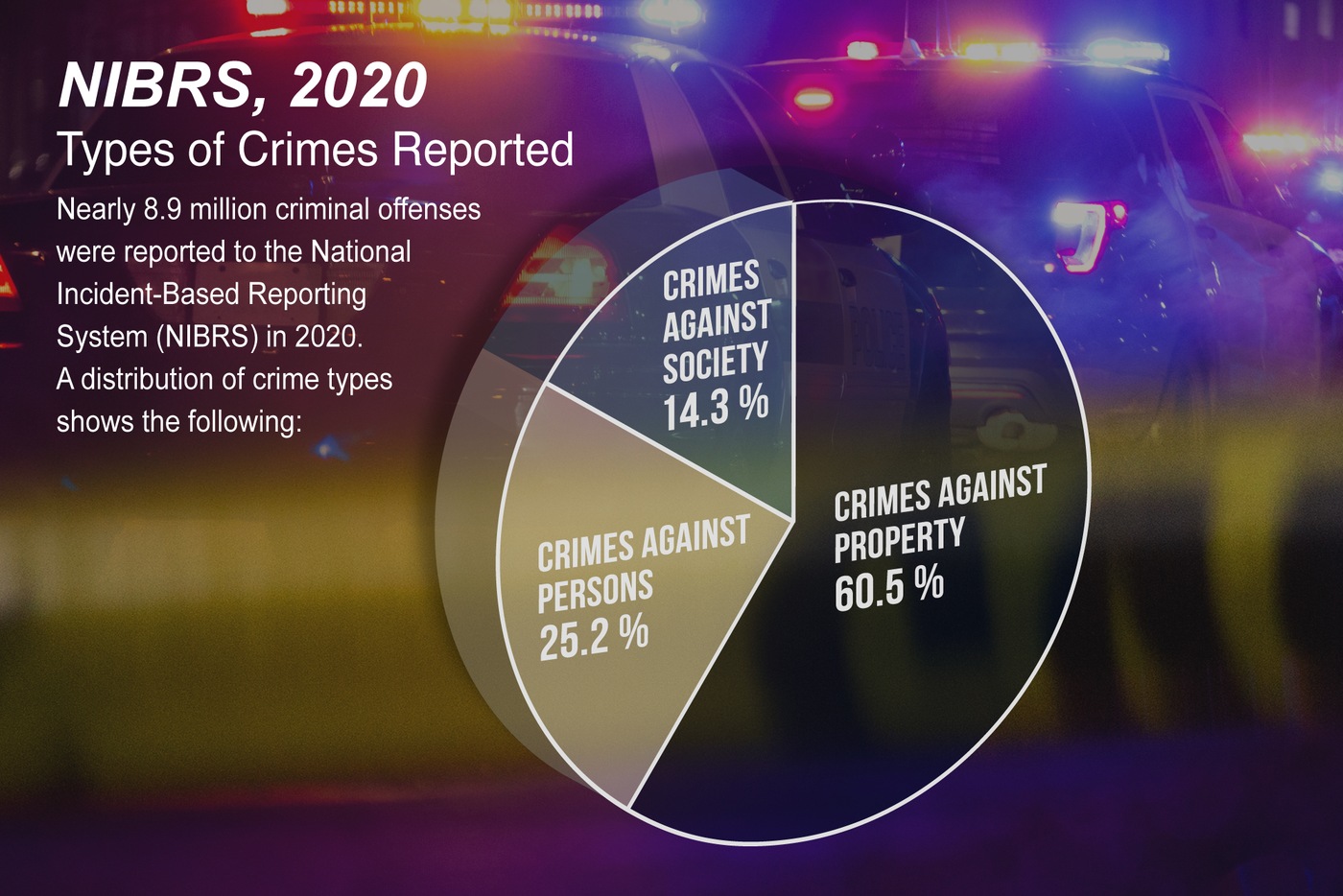https://www.fbi.gov/news/press-releases/press-releases/fbi-releases-2020-incident-based-data
FBI Releases 2020 Incident-Based (NIBRS) Data
Today, the FBI released detailed data on nearly 8.9 million criminal offenses reported via the National Incident-Based Reporting System (NIBRS) in 2020. The Uniform Crime Reporting (UCR) Program’s latest report, NIBRS, 2020, presents data about 23 offense categories comprised of 52 offenses. It also presents arrest data for those crimes, as well as 10 additional categories for which only arrest data is collected.
Highlights of NIBRS, 2020
In 2020, 9,880 law enforcement agencies, whose jurisdictions covered more than 177.5 million U.S. inhabitants, submitted NIBRS data to the UCR Program. These agencies accounted for 62.1% of the 15,901 law enforcement agencies that submitted data to the UCR Program in 2020. Currently, the FBI does not estimate NIBRS data for agencies that do not submit it.
Of the 8,879,728 offenses reported in 7,560,867 incidents, 60.5% were crimes against property; 25.2% were crimes against persons; and 14.3% were crimes against society. (Due to rounding, some percentage breakdowns may not add to 100%.) Among these categories, the offenses most reported include larceny/theft offenses, assault offenses, and drug/narcotic offenses, respectively.
Pie chart showing the breakdown of types of crimes reported in the NIBRS, 2020 report.
Read the full NIBRS, 2020 report.
Victims
The 9,362,709 victims reported via NIBRS include individuals, businesses, institutions, or society as a whole. For 2020, the data regarding the 6,597,394 victims who were individuals reveal the following:
Of these victims, 23.8% were between 26 and 35 years old.
A little more than half (50.6%) were female; 48.7% were male; and the gender of 0.8% of victims was unknown.
Most victims (66.9%) were white; 24% were Black or African American;
1.9% were Asian; 0.8% were American Indian or Alaska Native; and 0.2% were Native Hawaiian or Other Pacific Islander. The race of 6.2% of victims was unknown.
Data captured about the relationship of victims to their offenders show that just over half (50.1%) of the victims knew their offenders (or at least one offender when more than one was present) but did not have a familial relationship to them. Approximately one quarter (24.7%) of the victims were related to their offenders (or at least one offender when more than one was present). Of the remaining 25.2% of victims, the relationships to their offenders were categorized as strangers, mutual combatants (victim was offender), or unknown.
Known Offenders
Law enforcement reported information about 7,173,072 known offenders, meaning some aspect of the suspect—such as age, gender, or race—was known.
- Of these offenders, 38.2% were between 21 and 35 years of age.
- By gender, most offenders (62.1%) were male; 24.2% were female; and the gender for 13.7% of known offenders was unknown.
- By race, more than half (50.8%) of known offenders were white; 29.6% were Black or African American; and 2.2% were of other races. The race was unknown for 17.4% of reported known offenders.
Arrestees
Law enforcement agencies submitted data to the UCR Program through incident reports and arrest reports for 3,621,299 arrestees.
- Of these arrestees, 31.9% were 26 to 35 years of age.
- By gender, 72.6% were male; and 27.4% were female.
- By race, most arrestees (67.7%) were white; 27.1% were Black or African American; and 2.9% were of other races. The race was unknown for 2.2% of arrestees.
Agency-level NIBRS Data
State offense tables present statistics for each agency that reported 12 months of NIBRS data in 2020. In addition, federal offense tables present statistics for each federal agency that reported 12 months of NIBRS data. The interactive NIBRS map on the home page of NIBRS, 2020, also provides agency-level data.
Availability of NIBRS Data
2020 NIBRS data and companion documents are available exclusively on the Documents and Downloads page of the FBI’s Crime Data Explorer (CDE). The downloadable files also provide details such as location, time of day, and clearances at the incident level.
Users can also access other types of data on the CDE. Previous editions of the NIBRS publication contain data from 2011 through 2019.
Resources:

